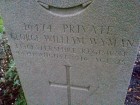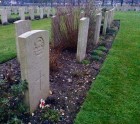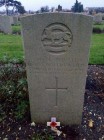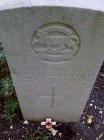George William Wyman
View George William on the Commonwealth War Graves Commission website
Known information
Private George William Wyman, son of Robert and Eliza Wyman, of Ridlington, was born on 3 March 1891 in the village. He was a farm worker living in Bank Cottage, East Lane and joined the 7th Battalion Leicestershire Regiment on 29 December 1914. According to information on display inside Ridlington Church, George joined up with his friend Bill Tyler from Preston. But the pair were separated when the Sergeant Major divided their group of soldiers into two units, bringing his pace stick down between the two friends. While Bill went out to Mesopotamia [Iraq] and survived the war, George was destined for the Western Front. He fought in the Battle of the Somme in which his battalion suffered heavy casualties at Bazentin-Le-Petit. After rest and reorganising, the 7th Leicestershires took over trenches north-east of Arras, across the road leading to Bailleul-Sir-Berthoult. George Phillips in Rutland and the Great War says George was killed in a mine explosion underneath the British lines on 14 August 1916. This part of the line was an area where both sides were heavily engaged in mining and counter-mining. Three existing craters known as Clarence, Claude and Cuthbert, each 60 feet deep, were in the Leicestershires' sector. The battalion war diary records that at 10pm on 14 August, the Germans blew a mine underneath Clarence crater. "The new crater was immediately occupied on both lips by A and B Coys. Enemy did not attempt to leave his trenches. It is thought he fired the mine in order to close in our galleries which were then only thirty feet away from him. Very good work was done in consolidating the near lip of the crater and digging out the men who were buried. The two companies in the firing line suffered eight casualties, all of which were killed." If this was indeed the explosion George Phillips refers to then there is some doubt about the day George Wyman actually died. Because there was clearly time to get him to the 11th Stationary Hospital, Rouen, 180 kilometres away, presumably wounded, although the Commonwealth War Graves Commission says he died on the same day. In any event, he is buried in St. Sever Cemetery, grave B.31.21, and is remembered in Ridlington Church.
See where all our Rutland soldiers died during the Battle of the Somme on our interactive map.

|
Do you know something about George William that hasn't been mentioned? You can add any new information and images as a contribution at the bottom of this page. |













.png)


.jpg)





Please wait